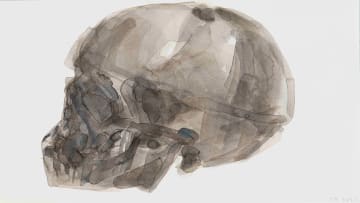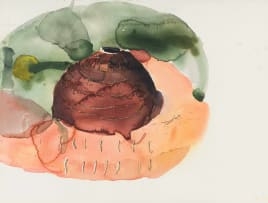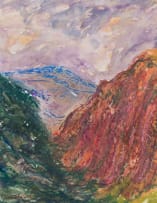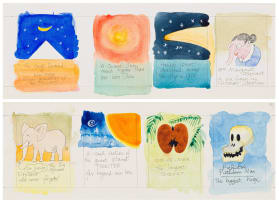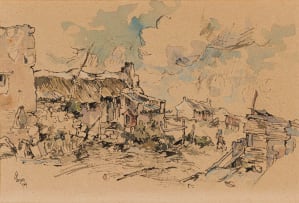Modern, Post-War and Contemporary Art
Online-Only Auction, 30 May - 13 June 2022
Watercolour: The Choreography of Chance and Control
About this Item
signed with the artist's initials and dated 2022 in pencil in the margin
Notes
"I have in my possession a book that I borrowed from Alan Crump on the work of another South African artist, Marlene Dumas. It is a book on her watercolours, and I treasure it for the ways it continues to inspire my own practice and thoughts about this medium, and also for the ways it stands as a link to my friendship with Alan, to those hours of looking at and talking about watercolour.
The book is called Wet Dreams which speaks volumes about the irreverence of Dumas' attitude to painting and her fierce directness. It also points to the uncontrolled emotional, perhaps even psychological nature of this medium. I recall listening to Dumas speaking about her exhibition Intimate Relations at the Standard Bank Gallery in 2008 and I had in my mind that she was like a flood: raging, fast, torrential, all consuming.
Watercolour, flooding, sexuality and force are not usually associated concepts. In her book she writes the following:
'For me watercolours used to be associated with failed artists (e. g. Hitler), retired politicians (e. g. Churchill) and Sunday painters. It was the most uncritical, non-aggressive asexual thing to do. Then its image changed. Now everyone is doing it. Falling for this seductive, addictive medium, it's hard to stop.'1
Possibly both the seduction and the addiction to watercolour is related to the balance of control and collapse; that tension that has to be held, managed, teased and tested.
In my own practice, and I see it in Dumas, and in Crump, also in South African artist Penny Siopis and others who reject the delicate 'non-aggressive asexual' connotations of watercolour, working with watercolour requires a practice of constant letting go and reigning in. Of her engagement with a medium that spills and pools, Siopis wrote:
'I am fascinated by the strangeness, openness and vitality of this choreography of chance and control, what floats, falls, fractures and fixes.'2
Art historian Karin Skawran wrote that in Crump's last series of watercolours:
'the abstracted images of Cinnamomum camphora (Camphor Trees, Vergelegen), appear as though their forms are governed by their own laws. The apparent spontaneity of his approach, however, did not preclude careful planning and control, deliberation and forethought.'3
There is control and there is submission, or risk. One afternoon when, as a young staff member at Wits University, I visited Alan I was shocked to find he had submerged a painting in the swimming pool to scrub it down. I always think of him when I take my own disastrous watercolours to the bathtub and erase them with the hand shower.
To make art is to engage in an encounter with the medium, and watercolour is perhaps one of the more unpredictable and feistier of mediums; powerful when unleashed."
1. Marlene Dumas (2003) quoted in Thomas Knubben and Tilman Osterwold (eds) Marlene Dumas: Wet Dreams, Städtische Galerie Ravensburg /Hatje Cantz: Germany, page 78.
2. Penny Siopis quoted in Gerrit Olivier (ed) (2014) Penny Siopis: Time and Again, Wits University Press: Johannesburg, page 186.
3. Karin Skawran in Federico Freschi (ed) (2011) Alan Crump: A Fearless Vision, Johannesburg Art Gallery: Johannesburg, page 49.
Joni Brenner
May 2022

